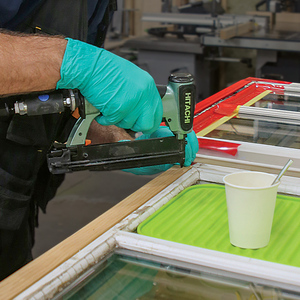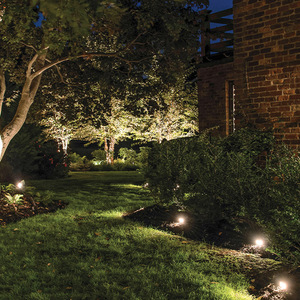I am writing in search of a resource that might have some answers for me about radiant heating.
I have an existing house in Massachusetts with radiant heating (sub-floor, staple-up, PEX, 2″ air space, 6″ f-glass, a final layer of Astro Foil applied 90 degrees to joists). Walls and ceilings are foamed with Corbond. Very tight and efficient.
This house is a second/future retirement home. It is not used frequently during the winter months, perhaps 1 or 2 times per month. Thermostats are currently set to 57 degrees.
It seems to make some intuitive sense to set the heat low while we are not there. That is, it must cost less energy to maintain a house (during the winter) at 57 than at 68.
Because of the nature of the thermal mass/radiant approach, getting the house to a comfortable temp requires about 8 hours. Although there are telephone controlled thermostats on the market, I have not been able to find any for radiant systems, probably because radiant is typically a set-and-forget system. We understand radiant does not respond well to the setback approach commonly used in radiator heating approaches.
We knew this going in and fully expect to have the house set to one operating temp once we are there full time. Until then, we are faced with the warm-up period for our off-season visits. Of course, these warm-up visits are offsetting at least part of the savings of keeping the heat down.
What I am trying to find out is if anyone is aware of any engineering studies concerning heat recovery and questions like this:
What is the approximate additional cost of setting the thermostat at 68? (e.g., instead of 57)
Are there any studies that have an approximate % cost increase per degree of comfort?
Should the temp be even lower than 57 if we are not there but 1-2 weekends a month?
Is there some sort of “balance point” between energy savings and warm-up costs? For example, if it were to cost just 5% more to keep the temp at 63, that might be worth it if the recovery was cut from 6 hours to 2 hours.
I suppose we could just set the temp to 50 in November and not come back until May, that would be the easiest (and cheapest) approach. However, we do enjoy the house during the cold months as well.
Alternatively, we can just spend the money to heat the house for a year and [after adjusting for degree days] compare to the prior year’s costs. Good as any approach I guess, just takes longer for the answers….
If anyone has any leads to some resources that might be able to help with these questions, it would be much appreciated.
Thanks very much.



















Replies
57 versus 68 defintely saves money. Without the size, insulation, tightness of your house and your fuel costs, I can't give you $, but I can estimate %. You will shortern your heating season by about a month on each end. And instead of 1700 degree days in January, you will have 1370. And that month is the smallest % saving. In April, for instance, you go from about 620 degree days to 290. Year-long savings: about 30%.
Don't give up on the telephone-activated start-up. It is an ideal solution for a vacation home. Maybe you just need a cleverer plumber or HVAC person to look at the system. For instance, if you can get a 120-volt telephone thermostat, you could run the pump or valves for most zones off of that. By which I mean the telephone thermostat AND the RFH thermostat must be on for those pumps or valves to be energized. e.g. the thermostats are wired in series. And then leave the lowest zone on all the time. For a base-load of heat and freeze-protect. Maybe leave the doors open to let the heat move around.
At 63F, you'd get about half the savings of 57F. It would heat up sooner and 63F isn't so bad to walk into anyway. That is the very low-hanging-fruit. Set it as low as don't mind returning to.
And, if someone can't figure out the telephone solution, look at adding a set-back thermostat(s) somehow. You could just turn it down to 50F every weekday and to 68F starting Friday afternoon. Whether you go that weekend or not, you'd get 5/7s of the savings of dialing back to 50F (about 45% of your costs) for a net savings of 5/7 of 40% = 28%.
I've seen some of your posts refer to radiant systems that have a thermostat/controller that has an input for the outside temperature, so it can start adding heat as soon as the weather starts cooling off, instead of waiting till the house cools off. Could JPDad get one of those, disconnect the exterior thermometer, and interface that input to the telephone device instead?
That approach would be difficult. The telephone remotes usually close a switch (rated to some amperage). That could replace a simple 24-volt or line-voltage thermostat. But a smart thermostat with an "outdoor reset" (called versus other things, too) would have a thermistor (most common, a temperature-varying resistor e.g varies from 10k to 25k ohms) or thermocouple (e.g. varies from 100 mv to 150 mv). Neither a thermistor or thermocouple could easily be swapped-out with a simple switch. And outdoor reset doesn't turn the system to a higher or lower set-point anyway. It just gets the system started earlier (if outdoor temps are falling) or shuts it down sooner (if outdoor temps are rising). David Thomas Overlooking Cook Inlet in Kenai, Alaska
Thanks very much to everyone who took the time to reply. From what people said (or didn't say), it seems there aren't any obvious sources of information concerning radiant heating costs at various temperatures.
On the separate front of pre-heating the house remotely, there are some good ideas. Unless I am reading the text incorrectly, it seems the concept of a "master" thermostat is possible. If true, that is very intriguing.
The house has five zones in its 2500 sq ft. (Den above the garage, upstairs bedroom, kitchen/living, master bedroom, guest room). Is it possible to wire the thermostats in such a manner that a master control can override the existing settings for the other thermostats? Given the 5 zones, this approach is the only way the telephone control would seem useful .
Thanks again for your responses. I appreciate your expertise.
each set back degree saves you 3% in energy costs - so if it is 57 now all teh time and you decide to set it at 63 degrees your energy cost would increase by approximatley 18%. You could easkily calculate the cost to pull it up to 68 degrees based upon the known 8 hour ramp-up time and the cost of energy.
I have a 2700 ft new house w/ 3 zones & have tuned it to stay at 69 through out.
I would get my alarm company to install a controller to work with a dialer.
I think Brinks and ADP can handle it.
If you have time and inclination, please tell us more about your 3 zones at 69F. What kind of system? High or low mass? Boiler or HWH? Professionally installed or DIY? etc etc.
"Is it possible to wire the thermostats in such a manner that a master control can override the existing settings for the other thermostats? Given the 5 zones, this approach is the only way the telephone control would seem useful."
You could have the "master control" energize the five thermostats - run the 24 volts through the master control. Or run the 120 volts that powers the 24-volt transformer through the master control. That way, unless the master is enabled, nothing happens.
Then add a simple t-stat in parallel for keeping it at 57F when you are away.David Thomas Overlooking Cook Inlet in Kenai, Alaska
I agree with Dave there is a way to do this by remote control.
The problem is that I am not familar with how the radiant heat is controlled.
One fix would be having two thermostats/controlers and then a relay to switch between them.
Yes, I like that. A regular RFH thermostat that expects and compensates for the lag-time and stability of RFH. And an off-the-shelf, set-back, time of day t-stat set to 55 or 50F. Leave the set-back t-stat in control when you drive away from the vacation home.
Then, six hours before your next arrival, call on the telephone remote to switch a relay that gives control to the smart RFH t-stat (left set at 69F).David Thomas Overlooking Cook Inlet in Kenai, Alaska
David, I have a quick question for you re RFH. Why wouldn't cpvc pipe with aluminum flashing cut in panel sizes for staple up, work as well as pex and the "designed" aluminum plates? (providing I could contour the aluminum to have good surface contact with the cpvc pipe.)PaulEnergy Consultant and author of Practical Energy Cost Reduction for the Home
I just did a google search and found this link and some others like it...
http://www.energyautomationinc.com/telephone-controlled.shtml
You could always give a good neighbor a key, with a promise to bring him a favorite 6 pack if whenever you called either a day or two before arriving, he would go into your house and turn your heat up.
If the 30% difference listed above is accurate, and that 30% turned out to be $30-$50, a $5-10 gift would be cheap. Plus, someone would have a key in case there was an emergency.
Just a little simplistic answer, that doesn't really answer your question, but that actually mirrors most of the answers I ever give!